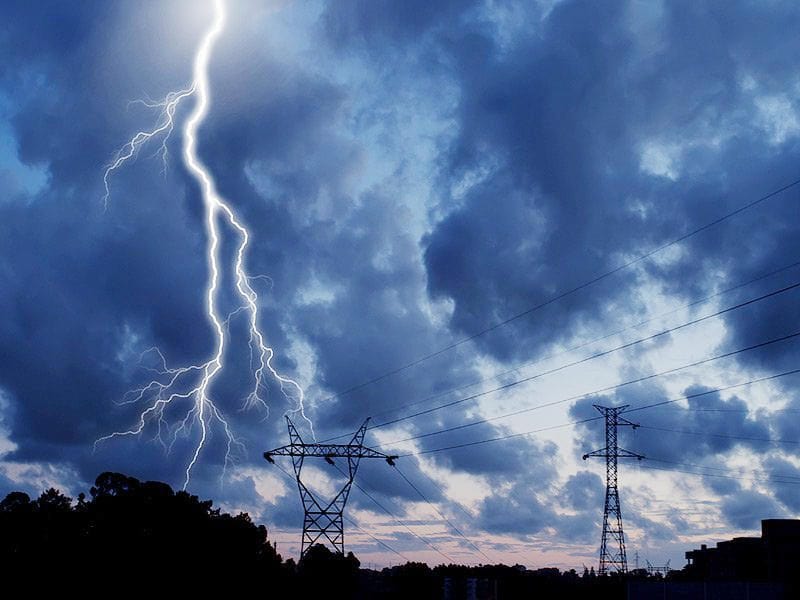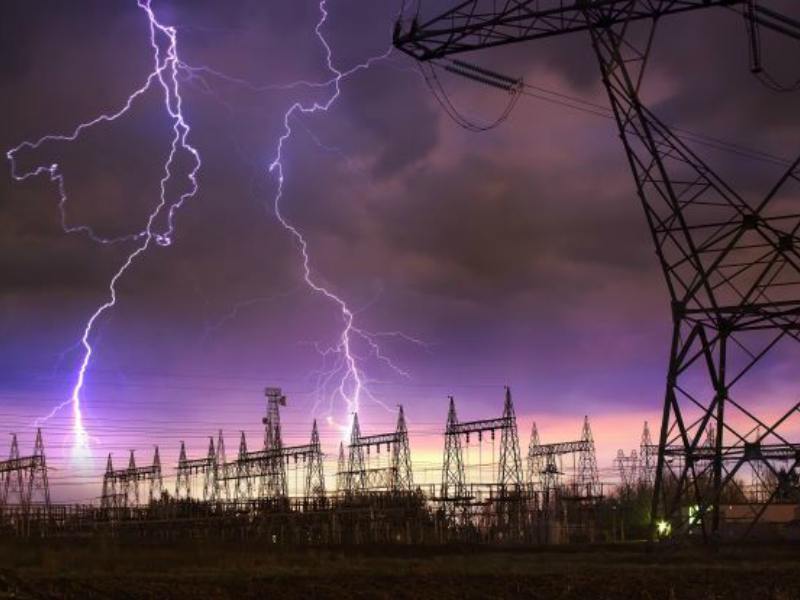
Dangers and damage caused by surge currents and overvoltages, usually caused by atmospheric discharges, i.e. lightning, are generally underestimated or even ignored.
Overvoltage protection – Causes of overvoltage
Surges and surge currents are often caused by lightning during a thunderstorm. This can be a direct lightning strike or so-called travelling waves. Another reason can be unforeseen switching operations in the substation.
Lightning
Lightning is the constant companion of every storm. When thunderclouds pile up at great heights, a separation of charges occurs inside them. This happens by friction and atomization of water particles. Thereby ice crystals are charged positively and the water droplets negatively. This creates an area of positive charge in the cold upper part of the cloud, while negative charge predominates near the ground.
The electric field increases until a voltage of several hundred million volts is reached. At some point, the field strength exceeds a critical threshold of about 170,000 volts per metre and a gigantic short circuit is announced: Lightning. It can discharge within the cloud or between the cloud and the ground.
Traveling waves
Travelling waves are another cause that leads to overvoltage. Due to its electrical charge, a thundercloud can form a charged capacitor with an overhead power line by influencing it. When lightning strikes or cloud-to-cloud lightning, the charge of the overhead line loses its bond with the charge of the cloud. The charge of the line that has now become free flows off on the line as surge current and overvoltage as travelling waves.
At the ends of the overhead line the overvoltage can be increased by reflection. However, the surge current of this phenomenon is much smaller, unless lightning strikes directly into the overhead line or into a building connected to it.
Switching operations
Switching operations, both inside and outside a building, can also cause overvoltages. This can be the occurrence and switching off of a short circuit or the operational switching on and off of a consumer with a high nominal current. Especially the switching off of inductors and capacities is critical. These can be transformers, frequency converters or large electric motors. However, the switching overvoltages and their surge currents are much smaller than those caused by lightning strikes. They can be transmitted by cable, capacitively or inductively.
Harmful effects of overvoltage
The damage caused by overvoltage in electric circuits can be quite impressive. For example, after heavy thunderstorms, lightning struck three residential buildings. According to the fire department, “sockets and switches literally flew out of the wall. Main fuses of the power supply had exploded. But there was no fire.” Damage to electronic equipment often occurs, which can lead to data loss or shutdown of operations, with all the negative consequences this can have, for example, for customer relations.
For example, the complete electrical system and the electronic control equipment of the stables was destroyed by the impact into an agricultural enterprise 130 km away. How this can happen we explain in the following sections.
Heat through surge current
Conductors which are not designed and dimensioned for surge currents (in final circuits or in information technology systems) can start to glow or melt or even evaporate explosively. Water-containing objects not intended as conductors (e.g. trees, wooden poles, masonry) can be blasted by the extremely rapid change in the aggregate state of the water to water vapour.

Surge current and magnetic forces
Conductors through which a surge current flows and which are arranged in parallel are subject to magnetic attraction when the current flows in the same direction and repel each other magnetically when the current flows in the opposite direction. If the distance between the conductors is small, they can be torn out of their sheaths, holders or clamps. Conversely, such magnetic fields can also cause current surges in other conductors through induction, so that the damage continues to propagate in the cable system.
Danger of step voltage
Step voltage is the electrical voltage between two points of a floor area through which a strong current flows. The name derives from the fact that this voltage affects a person or an animal when it touches the ground at different points. It can be life-threatening for people or animals. If a high electric current is introduced into the ground, this current generates an electric voltage at the electrical resistance of the ground according to Ohm’s law.
A body that touches two points of different potential in the area of the ground through which the current flows then bridges a voltage that can amount to several 1,000 volts and can therefore be life-threatening. If you are outdoors in the middle of a thunderstorm, you should make sure that your feet are close together on the ground. Under no circumstances should you lie on the ground.
Overvoltage protection – internal and external lightning protection
To protect against the consequences of overvoltage due to lightning strikes, an external and an internal lightning protection must be installed. The external lightning protection, commonly known as lightning arrester, consists of an interception device, arrester and earthing system.
It serves to divert the lightning into the ground and to minimise the fire hazard caused by a direct impact. Not all buildings are equipped with lightning conductors. These systems are particularly important for highly exposed buildings or farmsteads.
Internal lightning protection (lightning equipotential bonding & surge protection) is divided into coarse protection, medium protection and fine protection. The internal lightning protection is important even if no external lightning protection has been implemented. It protects against overvoltage caused by switching operations, but also against direct lightning strikes or impacts in overhead lines or transformer stations.
Overvoltage protection – is installation obligatory?
Surge protection is considered a necessary part of an electrical system. It must therefore be installed in new buildings. Surge protection is not mandatory for older buildings. Nevertheless, it is highly advisable to retrofit a surge protection.
This is because modern households use a large number of high-quality electrical devices that are connected to the power grid, such as televisions, cookers, routers or computers. All these devices contain sensitive electronics that can easily break down in the event of overvoltages.
Surge protection is essential, especially for the protection of sensitive electronics. Since the overvoltages that occur must be reduced step by step, it only makes sense to install all three stages of the overvoltage protection together. A socket strip with surge protection for the computer (fine protection) is useless in case of doubt if there is no surge protection of the first two stages (coarse protection and medium protection).

